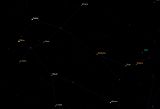• Messier 35 should top your list of things to see this month. No matter how often you observe this fine cluster, you will see new patterns and shapes in the interwined strands woven among this young cluster’s 300 stellar members.
• In binoculars, M35 looks like a tiny patch of frosted silver, with a few stars visible at most. In a 3-4-inch telescope you’ll see 40-50 stars, with more revealing themselves upon careful examination. In a 8-10-inch scope, the view of this cluster is awesome, with bright blue and white stars blazing in the field of view, along with a few red giants evolving off the main sequence.
• Unlike many star clusters, M35 has no central condensation. In fact, many observers see an absence of stars or a “hole” near the center of the cluster, which, with a little imagination, gives it the appearance of a sparkling sugar donut.
• M35 is barely visible to the naked eye in clear dark sky. And at magnitude 5.1, it appears quite faint because it’s spread out over an area of sky as large as the full Moon, just like the faint galaxy M33.
• To find M35, look just a couple degrees northwest of the star eta Geminorum, one of the feet of the constellation Gemini, the Twins. It’s coordinates are RA 6h09m, Dec +24d21m. The cluster is visible in the north and most of the southern hemisphere.
• The particulars: M35 is some 2,800 light years away, and spans a diameter of 30 light years. Like most open clusters, M35 is younger than most of the rocks in your back yard: it formed only 50 million years ago.

source....
No comments:
Post a Comment